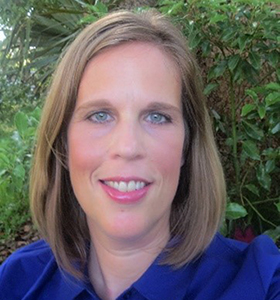Dr. Mary Lusk has joined the Soil and Water Sciences Department as an Assistant Professor of Urban Soil and Water Quality at the Gulf Coast Research and Education Center. We asked her to tell us about her background and future plans.
What is your vision for your research and Extension programs?

Research and extension go hand in hand and feed each other. My vision is to conduct research that helps us answer important questions for urban stakeholders and then be able to effectively communicate the findings of that research. For example, Florida is a rapidly urbanizing state, with an estimated 1000 people a day moving here. We need research on ways to protect soil health and water quality in an urbanizing landscape. That’s a big part of the research I do and is 100% of the Extension programming I do.
What part of your research program are you most excited about?
One niche I have made for myself is to be the person who focuses on the oft-ignored organic pool of nitrogen in urban soils and water bodies. I’m excited about continuing that work and developing a body of research to show how urbanization affects the transport and storage of nitrogen through organic pools (like soil organic matter, leachate from leaf debris, decaying plant material, etc.)
What part of your Extension program are you most excited about?
I enjoy working with the public and meeting with urban residents in their neighborhoods and talking with them about what’s going on in their lawns and stormwater ponds. I think people like to learn about stuff like that and it’s rewarding for me to be someone who can chat with them about science in their own backyards and how actions at their home landscape level can affect water quality in the entire community.
Are there particular projects or collaborations you have underway?
I started out in IFAS as a Water Regional Specialized Agent (RSA) in Extension. I was part of a 5-person team working statewide to address big water issues in Florida. It’s an awesome team that I plan (hope!) to continue working with. Among other things I’ve worked with RSA Andrea Albertin and some county agents along the Gulf Coast to develop a program on septic systems for residents of the springsheds (like Weeki Wachee Springs and Wakulla Springs, etc.). We’re making scale models of septic systems and doing a traveling outreach program to teach springs residents about how septic systems can impact water quality. On the research end of things, I collaborate often with the members of the CLCE, particularly AJ Reisinger, Basil Iannone, and Eban Bean. In one really exciting project, we’re looking at the effects of planted littoral shelfs on nutrient removal processes for urban stormwater ponds.
What do you foresee as being the biggest challenge ahead?
Squirrels. Haha. I say I’m like a dog being constantly distracted by squirrels because there are so many exciting research opportunities in the world of urban soil and water. My biggest challenge is recognizing that I can’t answer them all (Yet!). On a more serious note, one great challenge is the complexity of urban systems. We not only have biogeochemistry (which is already a whole systems science) but we’re doing it in an urban environment so now we have to throw humans into the mix. It becomes biogeochemistry plus sociology. People and urbanization change the playing field.
What motivates you most to go to work every day?
Wow, hard to pin down just one. Working with students is a great reward everyday—watching their enthusiasm and seeing them develop professionally and personally. I also stay motivated by all the exciting research opportunities I see. I really geek out over chemical formulas and biogeochemical processes, and any new piece of research that expands my understanding of those is exciting to me and keeps me with a long list of research to read up on and experiments to plan.
 0
0
